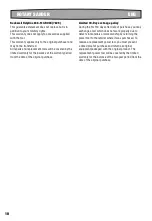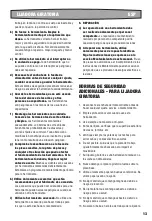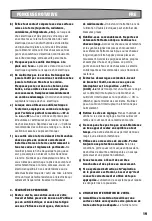
5
ROTARY SANDER
ENG
increase the risk of electric shock.
d) Do not abuse the cord. Never use the cord to
carry the tools or pull the plug from an outlet.
Keep cord away from heat, oil, sharp edges or
moving parts. Replace damaged cords immediately.
damaged cords increase the risk of electric shock.
e) When operating a power tool outside, use
an outdoor extension cord marked “W-A”
or “W”.
These cords are rated for outdoor use
and reduce the risk of electric shock. Refer to the
“Recommended sizes of Extension Cords” in the
accessory section of this manual.
f) Grounded tools must be plugged into an
outlet properly installed and grounded in
accordance with all codes and ordinances.
Never remove the grounding prong or modify
the plug in any way.
do not use any adapter
plugs. Check with a qualified electrician if you are in
doubt as to whether the outlet is properly grounded.
if the tool should electrically malfunction or break
down, grounding provides a low resistance path to
carry electricity away from the user.
3. PERSONAL SAFETY
a) Stay alert. watch what you are doing and use
common sense when operating a power tool.
do not use tool while tired or under the influence
of drugs, alcohol, or medication. a moment of
inattention while operating power tools may result in
serious personal injury.
b) Dress properly. Do not wear loose clothing or
jewelry.
Contain long hair. Keep your hair, clothing,
and gloves away from moving parts. Loose clothes,
jewelry, or long hair can be caught in moving parts.
Keep handles dry, clean and free from oil and
grease. Rubber gloves and non-skid footwear are
recommended when working outdoors.
c) Avoid accidental starting. Be sure switch is
“OFF” before plugging in.
Carrying tools with
your finger on the switch or plugging in tools that
have the switch “ON” invites accidents. do not use
a tool if the power switch does not turn it “ON” and
“Off”.
d) Remove all adjusting keys and wrenches.
Make a habit of checking that adjusting keys,
wrenches, etc. are removed from the tool before
turning it “ON”.
e) Do not overreach. Keep proper footing and
balance at all times.
Proper footing and balance
enable better control of the tool in unexpected
situations.
f) Use safety equipment. Always wear eye
protection.
dust mask, non-skid safety shoes,
hard hat, or hearing protection may be used for
appropriate conditions.
g) Keep hands away from all cutting edges and
moving parts.
h) if devices are provided for the connection
of dust extraction and collection facilities,
ensure these are connected and properly
used.
use of these devices can reduce dust-related
hazards.
4. TOOL USE AND CARE
a) Use clamps or other practical WAYS to secure
and support the work-piece to a stable
platform.
holding the work by hand or against your
body is unstable and may lead to loss of control.
b) Do not force tool. Use the correct tool for
your application.
The correct tool will do the job
better and safer at the rate for which it is designed.
Excessive force only causes operator fatigue,
increased wear and reduced control.
c) Do not use tool if switch does not turn it “ON”
or “OFF”.
a tool that cannot be controlled with the
switch is dangerous and must be repaired.
d) Disconnect the tool from the power source
before making any adjustments, changing
accessories, or storing the tool.
Such
preventative safety measures reduce the risk of
starting the tool accidentally.
e) Store idle tools out of reach of children and
other untrained persons.
Tools are dangerous in
the hands of untrained users.
f) Maintain tools with care. Keep cutting tools
sharp and clean.
Properly maintained tools, with
sharp cutting edges, are less likely to bind and
easier to control.
g) Check for misalignment or binding of moving
parts, breakage of parts, and any other
condition that may affect the tool’s operation.
if damaged, have the tool serviced before using.
Many accidents are caused by poorly maintained
tools.
h) Use only accessories that are recommended
Summary of Contents for RK4246K
Page 1: ...ROTARY SANDER PAG 4 ENG Lijadora giratoria PAG 11 ESP PONCEUSE ROTATIVE PAG 18 FRE RK4246K...
Page 3: ...RK4246K A B C D1 D2 E F 1 2 6 3 7 7 4 5...
Page 25: ......
Page 26: ......
Page 27: ......






































